Pack UVs
The Pack UVs tool automates the process of organizing UV island data to fit into the desired UV space. It could be thought of as an automated puzzle solver. With the default settings, the command moves, scales, and rotates each individual UV island until they all fit neatly within the designated grid space, as if solving a complex jigsaw puzzle.

Accessing the Pack Tool
• From the menu bar, click Texture > UV Operators > Pack....
• Using the Model layout, on the left panel, under Align and Pack, click Pack...
Applying the Pack UVs Command
The Pack UVs command modifies the currently-selected UV map.
Note: If you have selected multiple UV maps, the first one selected is used to apply the Pack UV command. Other selected UV maps are not affected.
For more information about how to create UV maps, see Create UV Tool.
| 1. | Under the menu bar, click UV to open the UV layout. |
| 2. | Download and open this model. |
| 3. | Select a texture map. There are a number of ways to do this: |
• On the bottom of the right panel, open the Lists tab, expand UV Maps, and select CharacterUV.
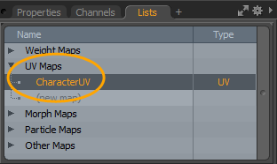
• Alternatively, on the left panel, set Map: (none) to CharacterUV.
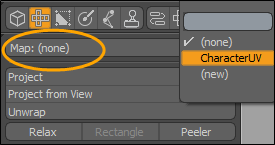
• Alternatively, on the UV viewport, click on the UV button, and select the CharacterUV from the dropdown menu.

The UV viewport displays the UV map.

| 4. | On the right panel, under Align and Pack, click Pack.... |
| 5. | On the Pack UVs dialog, click OK. |
Each individual UV island fits neatly within the designated grid space

Creating UV Islands Groups Based on Polygon Tags
The following example uses the teapot primitive which has multiple materials (polygon tags) applied to it, and includes a UV map. It demonstrates how to create individual UV islands and texture maps for each applied polygon tag.
For more information about how to create your own UV maps, see Create UV Tool.
| 1. | Under the menu bar, click UV to open the UV layout. |
| 2. | Download and open this model. |
| 3. | On the left panel, set Map: (none) to Texture. |
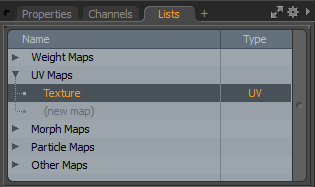
| 4. | On the left panel, under Align and Pack, click Pack... |
| 5. | In the Pack UVs dialog, set Pack Region to Polygon Tag, and click OK. |
Each polygon tag is packed into separate UV islands and grouped by same polygon tag.
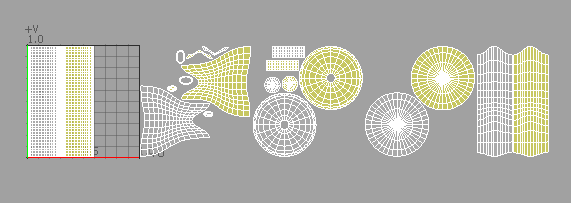
Tip: You can pack each polygon tag into separate UV maps by enabling the Pack UVs to New Map option. It retains the original UV map and names the separate UV maps based on the material name. These UV maps are listed on the right panel in the Lists tab under UV Maps. Clicking on each individual UV map displays it in the UV viewport.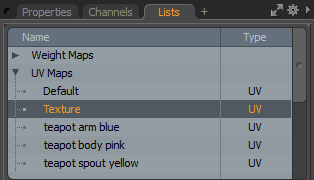
Splitting One UV Island with Multiple Polygon Tags
You can split a UV map which has only one UV island into individual UV maps based on applied polygon tags.
| 1. | Download this model. |
| 2. | In the UV layout, click Map (none) and select Texture. |
One UV island displays in the UV viewport.
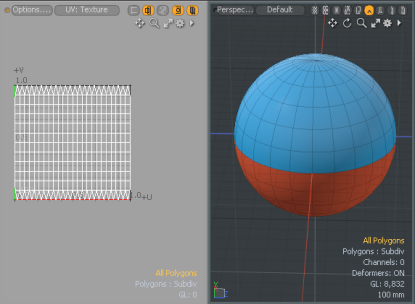
| 3. | On the left panel, under Align and Pack, click Pack... |
| 4. | In the Pack UVs dialog, set Pack Region to Polygon Tag and click OK. |
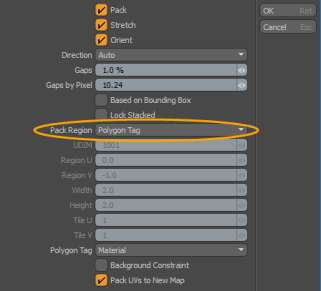
Two individual UV maps are created.
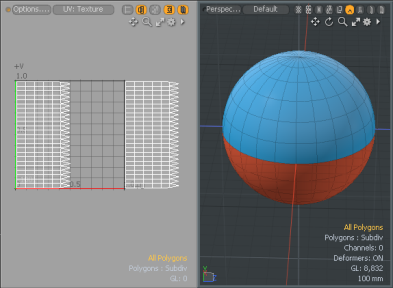
Pack UVs Properties

• Pack - Controls whether the UV islands can be moved from their current location.
• Stretch - Controls whether pieces are kept rigid or if they can be stretched (distorted) for a better fit.
• Orient - Controls whether the UV islands can be rotated as they are packed.
• Direction - Provides options for controlling the main orientation of the UV islands.
• Auto orients them in the direction that best fits.
• Horizontal orients UV islands in a mostly wide proportion.
• Vertical orients them in a mostly tall proportion.
• Gaps - Controls the final spacing between the islands. Greater values increases the spacing between neighboring UV islands.
• Gap by Pixel - Sets the padding by image pixel unit. This refers Image Size in Texel Density tool.
• Based on Bounding Box - When enabled, treats each island as a rectangular shape, based on the overall width and height.
• Lock Stacked - When enabled, keeps stacked islands intact when packing. Overlapping islands must share vertex positions, such as when UV mapped geometry is copied, pasted, and moved in the 3D viewport, or half of a model is mirrored for symmetry.
• Pack Region - Defines the location within the UV space to position the packed UVs.
• Normalized - Packs the UVs into the base 0 to 1 region. It has no options for control.
• Nearest - Packs the UVs into the closest UV region based on its initial location. It has no options for control.
• UDIM - Allows you to define a specific UDIM region. When selected, the specific UDIM is specified in the input field below.
Tip: UDIM is simply an automatic UV offset system that assigns an image onto a specific UV tile, which allows you to use multiple lower resolution texture maps for neighboring surfaces, producing a higher resolution result without having to resort to using a single, ultra high-resolution image. For more information, see UDIM Workflow.
• Manual - Allows you to manually designate a UV space region as a packing area. When selected the region is specified using the Region and Width/Height input fields below.
• Tiles - Defines a maximum rectangular area by number of full regions wide and high, defined with the Tile U and Tile V values. This targets the packing to fill all the tiled sections within the defined region (without crossing the tile boundaries).
• Polygon Tag - Groups UV islands by a polygon tag type to separate UDIM spaces. When enabled, you can specify the Material, Part, Smoothing Group, or Selection Set option to apply it to.
• UDIM - When the Pack Region option is set as UDIM, this option allows you to designate the specific UDIM region as the target for packing the UVs into.
• Region U/V and Width/Height - When the Pack Region option is set as Manual, the Region and Width/Height values designate the target area for packing the UVs into. The Region U/V values define the lower-left corner of the packing region and the Width and Height values define the portion of that area that is used for packing, originating from the defined region position.
For example, to fill all of the standard 0-1 UV space, the region would be set to 0,0 and the Width/Height would be set to 1.0, 1.0. If the region is set to -1,-1 and the Width/Height were set as 2.0, 2.0 then the UVs would fill the entire -1 to 1 on both axes, treating it as one giant UV area to pack into.
• Tile U/Tile V - Defines the rectangular tile region by U (width) and V (height) when using the Pack Region's Tiles option.
• Polygon Tag - Provides options to group UV islands by a polygon tag type to separate UDIM spaces.
The following options are available:
• Material - Uses the Polygon Set Material tags applied to the mesh item. It packs each polygon tag into a separate UDIM and updates the original texture UV map.
• Part - Uses the Polygon Set Part tags applied to the mesh item.
• Smoothing Group - Uses the Polygon Set Smoothing Group tags applied to the mesh item.
• Selection Set - Uses the selection set specified for the mesh item. For more information, see Using Selection Sets.

• Background Constraint - When enabled, packs UV islands into the empty spaces available.

• Pack UVs to New Map - When enabled, the original UV map is retained and individual UV maps for each applied polygon tag are created. If Polygon Tag is chosen for the Region Mode option, UV groups by polygon tag are exported to separate new maps per group and the name of new map is taken from polygon tag name. For example, if you had a material polygon tag called Red Teapot top, and the Polygon Tag option is set to Material, a UV map named Red Teapot top is created.